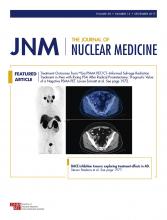Imaging of prostate cancer (PCa) plays an important role in guiding biopsy at initial diagnosis, in accurately evaluating the extent of disease, in assessing sites of recurrent disease, and in monitoring response to treatment. A variety of PET radiopharmaceuticals for PCa are in clinical trials or available commercially.
Prostate-specific membrane antigen (PSMA) is a transmembrane protein that is highly overexpressed on almost all PCas (1). Only 5%–10% of primary PCa lesions have been shown to be PSMA-negative (2), making this class of radiopharmaceutical suitable for diagnosis of primary PCa and for initial staging (3,4). Use for noninvasive tumor grading has also been reported (3). High accuracy has been reported for use in detecting biochemical recurrence, even at very low prostate-specific antigen levels (5,6). However, these promising agents do not detect all recurrences (5,7), and other types of cancer also express PSMA (8,9). False-positive findings have also been reported using PSMA agents (10–12). Given the widespread adoption of PSMA radiopharmaceuticals and their excellent performance at all stages of PCa, is there a need or a role for another class of PET radiopharmaceutical targeting other biologic processes in PCa?
Gastrin-releasing peptide receptor (GRPR) is a G-protein–coupled receptor overexpressed in many types of cancer, such as PCa, breast cancer, and small cell lung cancer (13). It belongs to the bombesin receptor family. Bombesin is a 14-mer peptide (Pyr-Gln-Arg-Leu-Gly-Asn-Gln-Trp-Ala-Val-Gly-His-Leu-Met-NH2) that binds with high affinity to the GRPR (14). Clinically translated GRPR antagonist PET radiopharmaceuticals include 68Ga-RM2, 68Ga-SB3, 68Ga-NeoBOMB1, 18F-BAY-864367, and 64Cu-CB-TE2A-AR06. They have a stable biodistribution in healthy volunteers (15) and mean effective doses comparable to those of other radiopharmaceuticals (16,17). Data are encouraging regarding their potential for the initial diagnosis of PCa (15–19), for the assessment of biochemical recurrence (15,16,18–23), and for the theranostic approach (24). The lack of salivary or lacrimal gland uptake and the low hepatobiliary clearance give them an advantage. The high pancreatic uptake may be of concern to some; however, although initial uptake is high, it decreases rapidly whereas tumor radioactivity is retained longer (24). A comparison of 68Ga-RM2 PET scans before and after treatment is shown in Figure 1, and comparisons of paired 68Ga-PSMA-11 and 68Ga-RM2 scans are shown in Figure 2.
72-y-old man with history of Gleason 3 + 4 PCa treated with radiation and hormonal therapy, presenting with prostate-specific antigen level of 3.7 ng/mL. Maximum-intensity-projection 68Ga-RM2 PET images before (A) and after (B) radiation treatment demonstrate resolution of prostate bed uptake (arrow).
Maximum-intensity-projection PET images from 68Ga-PSMA-11 and 68Ga-RM2 PET scan pairs show no uptake on 68Ga-PSMA-11 PET and focal uptake (arrow) in retroperitoneal lymph nodes on 68Ga-RM2 PET (A), focal uptake (arrow) in retroperitoneal lymph nodes on 68Ga-PSMA-11 PET and no uptake on 68Ga-RM2 PET (B), and focal uptake (arrows) in seminal vesicle on both 68Ga-PSMA-11 PET and 68Ga-RM2 PET (C).
Although the overexpression of PSMA is ubiquitous in PCa, it is not universal and there will be lesions not detected by PSMA-targeted imaging in different risk classes or stages of disease. The influence of GRPR expression on cancer grade and stage is not clear. Nagasaki et al. (25) found that GRPR expression was positively correlated with Gleason score, but another study found that GRPR expression was inversely correlated with Gleason score, preoperative prostate-specific antigen concentration, and tumor size (26). Therefore, the indication (i.e., low- vs. intermediate- vs high-risk, and early vs. late stage of disease) for the use of PSMA- vs. GRPR-targeted imaging or both is an active focus of research.
Another unsettled question is whether the uptake is specific for (prostate) cancer. High uptake was reported in primary PCa lesions and metastases (16,18,23), but benign prostate hypertrophy resulted in false-positive findings in some cases (16). This may be avoided by the development of appropriate metrics of image interpretation. In our experience with 68Ga-RM2, all 7 biopsied lesions (prostate, lymph nodes, liver, and lung nodule) were confirmed PCa (22). As GRPR-targeting radiopharmaceuticals are evaluated in more patients, it is likely that more reports of non–cancer-specific uptake will emerge, as with any new class of radiopharmaceutical.
There are limitations to the data supporting the use of GRPR-targeting PET peptides, including small clinical studies, limited gold standards, and limited outcome data based on their use. Larger studies are needed to confirm preliminary results. However, given the complexity of the biologic processes identified in PCa, it is unlikely that any one group of imaging agents will provide all the answers needed to offer the best care for these patients. Therefore, the continued development and introduction to clinical use of GRPR-targeting PET radiopharmaceuticals will continue, if not as direct competitors of PSMA-targeting tracers, then as complementary diagnostic and therapeutic approaches. The sum is better than the parts after all.
DISCLOSURE
No potential conflict of interest relevant to this article was reported.
Footnotes
Published online Sep. 28, 2017.
- © 2017 by the Society of Nuclear Medicine and Molecular Imaging.
REFERENCES
- Received for publication August 28, 2017.
- Accepted for publication September 13, 2017.









